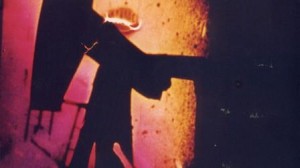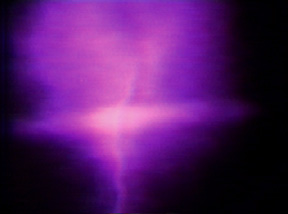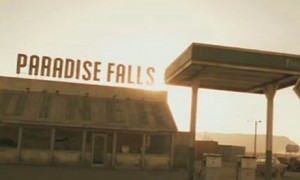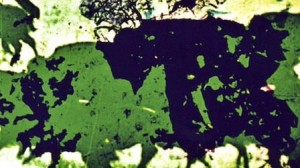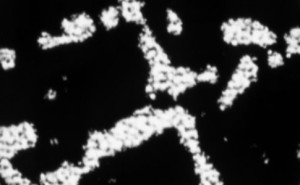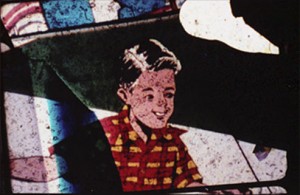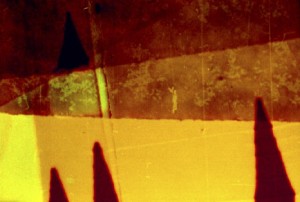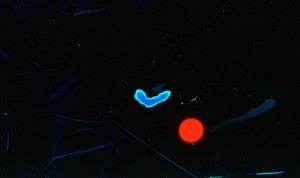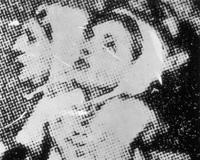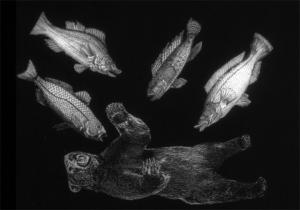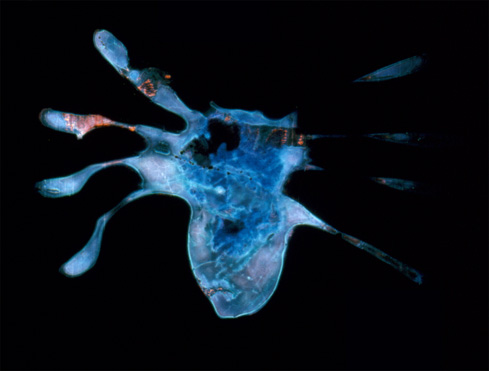
Christina Battle films (2002-2006)
Cooper/Bridges Fight 3 minutes, 16mm black and white optical sound 2002
This movie replays an excised moment from the canonical Western High Noon. Gary Cooper stars as the sheriff who is shunned by the very townspeople he tries to help. Lloyd Bridges plays his deputy, part of the ebb tide that withdraws from Cooper even as the killers he jailed to keep the town safe are on their way back for revenge. So the Cooper and Bridges fight isn’t exactly two sides of a question, more like two sides of one side.
Cooper is blindsided by his deputy, moments of his fall are replayed in slow motion and reverse motion. The artist’s bruised emulsion lends a visceral touch, the image itself looks like it’s flying apart under the force of their blows. Cooper rallies from the sucker punch, the two of them roll along the floor in a gesture that might be love. Moments of the fight are rephotographed in close-up, the picture stretched and squeezed, rapidly cut, and in the end the emulsion shatters. The fight is over, waiting to be rethreaded and replayed, over and over.
oil wells: sturgeon road & 97th street 3 minutes, 16mm, colour optical sound, 2002
Shot in the artist’s home province in Alberta, the mechanical rising and falling of an oil well is subject to a suite of rephotography applications (recoloured, superimposed, speed changes). Views of far and near are juxtaposed. Theme and variations, not with a piano, but an oil derrick on a prairie field, rising and falling.
fall storm (california, 2003) 3 minutes, video, colour, January 2004
On the soundtrack the wind gathers, thunder rolls and breaks, a storm is coming. But the image is nearly featureless, a blank screen scored by soft light, lit from within clouds which have been re-coloured pink and purple and orange. These eruptions of light do not illuminate a scene or make clear a sense of place, instead they are swallowed by darkness, they can illuminate only themselves, their own small moment in the night sky. A lightning bolt, a passing cloud, can these “natural” phenomena be bottled and preserved next to paintings by Rothko or Agnes Martin? There is never panic but instead, we settle into a darkness which has grown familiar, more usual than the gaudy instants of light. This is a movie for the ears. A move designed to stage the act of hearing. A familiar night after all.
paradise falls, new mexico 5 minutes, 16mm (dual projection), black and white, optical sound 2004
A split-screen projection in black and white. On the right a series of high contrast desert landscapes, made in America. On the left the more familiar form of these landscapes appear in the American Western. A medley of scenes appear showing a night time settlement. A woman framed in a doorway looking out into the vast abyss of space around her, three men on horseback riding into town, a man handing a rifle to his neighbour on a horse, a train arriving, a man riding through town slowly on a horse, a sheriff walking main street with a rifle, an exchange of male looks (in the Western these looks are already a form of violence), a gunfight, a man slumping dead, horse and rider making their way into the sunset. The cowboy is nomadic, predatory, deadly, never at home. The land, at least as it appears on the right hand screen, “in the present,” is “empty,” vacant, cleared out, only the myths remain.
The figure that appears on neither screen are the First Nations people, hunted down and killed as if they were not human. This genocide is turned, via the myth of the wild west, into a capitalist lullaby, more promised lands for the white Christians to occupy, though their imperial expansions would not end with Native genocide. Some of these same troops would be used to fight the Spanish-American war, as the US set up concentration camps in the Philippines and “liberated” Cuba for its new right wing dictator (friendly to America, of course). One empire taking the place of another.
buffalo lifts 3 minutes colour silent 16mm handprocessed film june 2004
A yellow and black and green daydream of the buffalo herd as it travels across a stretch of broken emulsion. The image of the buffalos was produced by boiling the original pictures and resettling them onto a new length of film (a process called “emulsion lifting,” hence the title). But the migrations of the herd have not managed quite as easily as their filmic counterparts, forced to move from long established grazing patterns, they have been hunted into virtual extinction across North America. This is a rumination on the fragility of these powerful masses in flight. And would it be too much to remark, in the midst of so much loping towards extinction, that this could be a metaphor for chemical-based movies? Is this the last graze of an analog touch, the pictures moved by hand, driven, corralled and penned into a digital corner? Allow one last flourish before these flickering shards will be part of someone else’s nostalgia. A memorial dirge, a travel without destination, a funerary rite.
following the line of the web 4 minutes, 16mm, black and white silent november 2004
Processing by hand means also to give oneself over to the chance encounter, there is nearly a kind of occultism at work, an automatic writing, a hand guided by spirits. Inscribed into the dark emulsion of this movie is a white grid (since the Renaissance an emblem of orderliness in the visual world, a mapping of space which ensured that hierarchies of visibility and ownership would be maintained. The subject position stabilized.) Here the grid emerges as a more fugitive principle, its totalizing impulse thwarted by its shuddering, kinetic application. Inside the grid lines there are further separations and subdivisions, a teeming, molar, microverse of life, ant colonies underfoot. We move into parts of the grid and examine its molecular structure, we move away from its wavering lines, attracted and repulsed, more and less aware of the foundational structures which continue to frame our lives. (Dad, is that you?)
nostalgia (april 2001 to present) 3.5 minutes, 16mm, handcrafted colour, sound, january 2005
In a colour fest of broken emulsions, the artist reconvenes a suite of feel good 50s adverts for a better life. A young boy on a bicycle, a blonde smiler on a tricycle, two men at a clothesline, the crisp border of neighborhood lawns appearing as if no one had ever set foot on them. The world is blank and the first line I lay across it is perfect, and then the second marks an intersection and the town is born. Everything recognizable as a picture arrives via drawings, stills, which are gathered here in a restless, teeming movement. Animation but not Saturday morning cartoons.
Mom waves good-bye to her two darlings at the front door. They have never had a problem because those words haven’t been invented yet. No shadows, no sense that there was ever a moment that wasn’t this moment. Whose nostalgia does this white world belong to? Whose idea of perfect is this? In the hands of the artist each frame has been stressed and fractured and re-presented with all of the fault lines clearly on display. Cohen liked to sing to us, “There is a crack in everything. That’s where the light comes in.” The drunken band plays on, the strings staggered and staggering. Who will tell them to stop?
the distance between here and there 7.5 minutes, 16mm, handcrafted colour, april 2005
An abstract film made by applying colour tapes directly onto emulsion and exposing it to light. The film presents colour fields in motion, though for the most part the ground is white like a gessoed canvas, and filled with a moving curtain of dust and hair and spots. In order to relieve the regularity (the tyranny?) of the projector’s 24 frame per second pulse, freeze frames are introduced, showing up and isolating a jagged crimson edge, an orange wall with its soft cracks, a yellow corner. After isolating, and setting apart colours in the film’s opening movement, they are brought together in a careening, flickering collage in the film’s second minute. Anticipating and then re-blending the afterimages of these ragged colour fields, the palette slowly darkens as the layers accumulate, canceling out the brilliance of “pure” colours. A visceral, physical cinema making the eyeballs sweat. Hidden colour codes of the synapses firing: a new thought is being born, and a new movie to accompany it.
migration 5.5 minutes, 16mm, handcrafted colour film, sound, may 2005
A night sky filled with stars, or an emulsion bearing the marks of hand processing, a flashing smudge of red and then blue, as if you were wandering down a hallway before stepping into a brightly lit room, the shock of colour arriving before language introduces a name and a face, before the world becomes familiar again, and unseen, invisible beneath the words.
It’s raining, the storm has begun, the analogue crackle and hiss rhyming the emulsion transport. Across this broken field a yellow butterfly, then blue, then yellow and green, then yellow, makes its way across the screen. It is only a shape, a contour, a silhouette, the small wings flapping, the brilliant colours changing and changing again. No beginnings and no end. We are always in this rain, we’ve become this storm. We’re on the way. No use asking when we’ll arrive, we’ll be dead then.
hysteria 4 minutes, 35mm, sound, 2006
Like nostalgia (april 2001 to present), this film is made up entirely of drawings. They show a house from the past century, the cartoonish figure of a man, a woman’s uplifted face praying, and then another. They are lent movement through the act of hand processing, a hail of scratches and blemishes course through the picture, reminding us that we are watching a loop of emulsion unspool. The image turns briefly and occasionally from positive to negative, the likely result of “flashing” the film in the development process, quickly exposing it to light “prematurely.” This technique emphasizes the dual nature of the chemical image. Typically negatives are printed to create a positive for viewing. By showing us both at the same time, the artist remarks upon the usually hidden “dual” nature of the picture—and it is hardly a coincidence that these technical namings (negative versus positive) carry distinct moral implications.
A Puritan woman points at another in a gesture of accusation while a crowd looks on, an arm points at a woman praying in front of a tribunal. Near the two minute mark the cartoonish figure of a man returns, this time emulsion lifted, flickering and shaking in an agitated dance. Dark figures in distress slide through the frame, there is a hanging, and then the emulsion lift frenzy is over. The silhouette of a hanged woman stands clear, a reminder of witch hunts past and present, the easy seduction of surfaces, and the migrations of names to these surfaces. Kike, polack, fairy, nigger, witch.
three hours, fifteen minutes before the hurricane struck 5 minutes, 35mm, sound, january 2006
The title opens with an ellipsis, as if something (the most important something?) has already happened. (“I fell in love with him… three hours, fifteen minutes before the hurricane struck). Once again the artist turns to found footage for her inspiration. Line drawings of plants and animals are clipped from different scales and crowd into the frame. Butterflies and bulls and then fade out. A title reads: the lights begin to flicker. Three frogs appear belly up. A title announces: the sky turned black. A picture shows four fish and a bear. Title: i sat in silence. Three hawks landing on two mushrooms and a fox. Title: the wind started picking up. Four diving pigeons and a horse with his head lowered. Title: trees started falling. Alligator eating a couple of chickens. Title: my hands trembled. Four crickets, a resting eagle and four seashells. Title: the night gave way to noises… Four bats, three mushrooms and a creature with a long tail. Title: … and howling in the dark. And a last title, the same as the first, three hours, fifteen minutes before the hurricane struck.
There is time enough to construct (and de-construct) stories from these fragments, these offerings the artists makes in hope that we will meet her half way. The consumer as producer, the audience as collaborator, adding the finishing touch.
traveling thru with eyes closed tight (map #2-january 03 thru january 06) 4 minutes, 35mm, colour, january 2006
Is it a perceptual documentary? Not a faithful record of what was right there in front of her but instead a record of the mechanisms of memory itself. The sound of a car issues and there is darkness, perfect and unrelieved. On the soundtrack there are Spanish voices and music from across a square. People are meeting, and then, without warning, nearly two minutes into the movie the pictures arrive, like a wayward uncle come too late for an important lunch, breathless and speaking about everything at once, as if to make up for the hour. The first image shows the wing of a plane, and then a backlit street with a small grey car pulling out, a tree, a telephone pole, a field of flowers, tram wires, further views of the country. Each lasts only a few frames, one erases the next in a blur of moments which will not be stilled and calmed and remembered. They exist in a democracy of time, these landscapes and cityscapes, and so become indistinguishable. A democracy of forgetting. There are views of the water, the beach, cars, again the plane (is it the same plane? Or is this another trip? Are we moving forward (is there progression?) or are we caught in an infernal cycle of repetitions? Tropical plants, alleyways, and then it’s winter, this has to be Toronto, the city we share (are cities shared, like meals?) and then it’s over. Though the sound runs on for another minute or so in the darkness, the darkness again. She’s been away but she’s returned, home again, managing to hold onto nothing, Or perhaps the memory of memory… wasn’t there something about? A glass half full and half empty. Twice upon a time.
Behind the Walls and Under the Stairs 3 minutes, 35mm, sound, 2006
Phantasmic photograms crawl across the emulsion, their flow arrested via re-photography, these marks look like multi-hued spiders crawling towards a new berth. Again and again. Falling from the horizon of the frame line in warm hues of red and purple and brown. A movie of theme and variations, noting the small changes of tone and texture and opacity. Every day I don’t have a new best friend, a new job, a new home. I live within the frame, trying to find freedom in my restrictions, my life.

